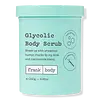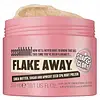What's inside
What's inside
 Key Ingredients
Key Ingredients

 Benefits
Benefits

 Concerns
Concerns

 Ingredients Side-by-side
Ingredients Side-by-side

Water
Skin ConditioningPumice
AbrasiveGlycolic Acid
BufferingPalmitic Acid
EmollientCetearyl Alcohol
EmollientStearic Acid
CleansingSodium Hydroxide
BufferingLactic Acid
BufferingGlycerin
HumectantCetearyl Olivate
Sorbitan Olivate
EmulsifyingXanthan Gum
EmulsifyingCocos Nucifera Oil
MaskingMelaleuca Alternifolia Leaf Oil
AntioxidantTocopherol
AntioxidantSodium Hyaluronate
HumectantHamamelis Virginiana Leaf Extract
Skin ConditioningNiacinamide
SmoothingAleurites Moluccanus Seed Oil
Skin ConditioningEucalyptus Globulus Leaf Oil
PerfumingMacadamia Ternifolia Seed Oil
EmollientLeuconostoc/Radish Root Ferment Filtrate
AntimicrobialAloe Barbadensis Leaf Juice Powder
Skin ConditioningAlthaea Officinalis Root Extract
Skin ConditioningLycium Barbarum Fruit Extract
AstringentCharcoal Powder
AbrasiveVitis Vinifera Seed Oil
EmollientTheobroma Cacao Seed Extract
AntioxidantQuartz
AbrasiveLauric Acid
CleansingMyristic Acid
CleansingArachidic Acid
CleansingBenzyl Alcohol
PerfumingPhenoxyethanol
PreservativeAlcohol
AntimicrobialParfum
MaskingLimonene
PerfumingWater, Pumice, Glycolic Acid, Palmitic Acid, Cetearyl Alcohol, Stearic Acid, Sodium Hydroxide, Lactic Acid, Glycerin, Cetearyl Olivate, Sorbitan Olivate, Xanthan Gum, Cocos Nucifera Oil, Melaleuca Alternifolia Leaf Oil, Tocopherol, Sodium Hyaluronate, Hamamelis Virginiana Leaf Extract, Niacinamide, Aleurites Moluccanus Seed Oil, Eucalyptus Globulus Leaf Oil, Macadamia Ternifolia Seed Oil, Leuconostoc/Radish Root Ferment Filtrate, Aloe Barbadensis Leaf Juice Powder, Althaea Officinalis Root Extract, Lycium Barbarum Fruit Extract, Charcoal Powder, Vitis Vinifera Seed Oil, Theobroma Cacao Seed Extract, Quartz, Lauric Acid, Myristic Acid, Arachidic Acid, Benzyl Alcohol, Phenoxyethanol, Alcohol, Parfum, Limonene
Glycerin
HumectantSodium Chloride
MaskingCaprylic/Capric Triglyceride
MaskingMaris Sal
Skin ConditioningSucrose
HumectantGlyceryl Stearate
EmollientPolysorbate 20
EmulsifyingPEG-100 Stearate
Parfum
MaskingPrunus Persica Seed Powder
AbrasiveVitis Vinifera Seed Oil
EmollientButyrospermum Parkii Butter
Skin ConditioningPrunus Amygdalus Dulcis Oil
Skin ConditioningDipropylene Glycol
HumectantHexyl Cinnamal
PerfumingLimonene
PerfumingButylphenyl Methylpropional
PerfumingBenzyl Salicylate
PerfumingLinalool
PerfumingBHT
AntioxidantGeraniol
PerfumingAlpha-Isomethyl Ionone
PerfumingGlycerin, Sodium Chloride, Caprylic/Capric Triglyceride, Maris Sal, Sucrose, Glyceryl Stearate, Polysorbate 20, PEG-100 Stearate, Parfum, Prunus Persica Seed Powder, Vitis Vinifera Seed Oil, Butyrospermum Parkii Butter, Prunus Amygdalus Dulcis Oil, Dipropylene Glycol, Hexyl Cinnamal, Limonene, Butylphenyl Methylpropional, Benzyl Salicylate, Linalool, BHT, Geraniol, Alpha-Isomethyl Ionone
 Reviews
Reviews

Ingredients Explained
These ingredients are found in both products.
Ingredients higher up in an ingredient list are typically present in a larger amount.
Glycerin is already naturally found in your skin. It helps moisturize and protect your skin.
A study from 2016 found glycerin to be more effective as a humectant than AHAs and hyaluronic acid.
As a humectant, it helps the skin stay hydrated by pulling moisture to your skin. The low molecular weight of glycerin allows it to pull moisture into the deeper layers of your skin.
Hydrated skin improves your skin barrier; Your skin barrier helps protect against irritants and bacteria.
Glycerin has also been found to have antimicrobial and antiviral properties. Due to these properties, glycerin is often used in wound and burn treatments.
In cosmetics, glycerin is usually derived from plants such as soybean or palm. However, it can also be sourced from animals, such as tallow or animal fat.
This ingredient is organic, colorless, odorless, and non-toxic.
Glycerin is the name for this ingredient in American English. British English uses Glycerol/Glycerine.
Learn more about GlycerinLimonene is a fragrance that adds scent and taste to a formulation.
It's found in the peel oil of citrus fruits and other plants such as lavender and eucalyptus. The scent of limonene is generally described as "sweet citrus".
Limonene acts as an antioxidant, meaning it helps neutralize free radicals.
When exposed to air, oxidized limonene may sensitize the skin. Because of this, limonene is often avoided by people with sensitive skin.
The term 'fragrance' is not regulated in many countries. In many cases, it is up to the brand to define this term. For instance, many brands choose to label themselves as "fragrance-free" because they are not using synthetic fragrances. However, their products may still contain ingredients such as essential oils that are considered a fragrance.
Learn more about LimoneneParfum is a catch-all term for an ingredient or more that is used to give a scent to products.
Also called "fragrance", this ingredient can be a blend of hundreds of chemicals or plant oils. This means every product with "fragrance" or "parfum" in the ingredients list is a different mixture.
For instance, Habanolide is a proprietary trade name for a specific aroma chemical. When used as a fragrance ingredient in cosmetics, most aroma chemicals fall under the broad labeling category of “FRAGRANCE” or “PARFUM” according to EU and US regulations.
The term 'parfum' or 'fragrance' is not regulated in many countries. In many cases, it is up to the brand to define this term.
For instance, many brands choose to label themselves as "fragrance-free" because they are not using synthetic fragrances. However, their products may still contain ingredients such as essential oils that are considered a fragrance by INCI standards.
One example is Calendula flower extract. Calendula is an essential oil that still imparts a scent or 'fragrance'.
Depending on the blend, the ingredients in the mixture can cause allergies and sensitivities on the skin. Some ingredients that are known EU allergens include linalool and citronellol.
Parfum can also be used to mask or cover an unpleasant scent.
The bottom line is: not all fragrances/parfum/ingredients are created equally. If you are worried about fragrances, we recommend taking a closer look at an ingredient. And of course, we always recommend speaking with a professional.
Learn more about ParfumVitis Vinifera Seed Oil comes from the grape vine. Grape seeds are a byproduct of creating grape juice or wine.
The components of grape seeds have many skin benefits. Research has found it to be antimicrobial and anti-inflammatory. It also contains many potent antioxidants such as Vitamin E , Vitamin C, proanthocyanidins, polyphenols, flavonoids, and anthocyanins. Proanthocyanidin has been shown to help even out skin tone.
Antioxidants help fight free-radical molecules. Free-radical molecules are capable of damaging our cells and other genetic material. Antioxidants help stabilize free-radicals by donating extra electrons. Grape seed extract may help reduce the signs of aging.
The antimicrobial properties of grape seed may help treat acne. However, more research is needed to support this claim.
Grape seed has also been found to help absorb UV rays. Grape seed extract should not replace your sunscreen.
The fatty acids of grape seed oil give it emollient properties. Emollients help soothe and soften your skin by creating a film. This film traps moisture within, keeping your skin hydrated.
Learn more about Vitis Vinifera Seed Oil